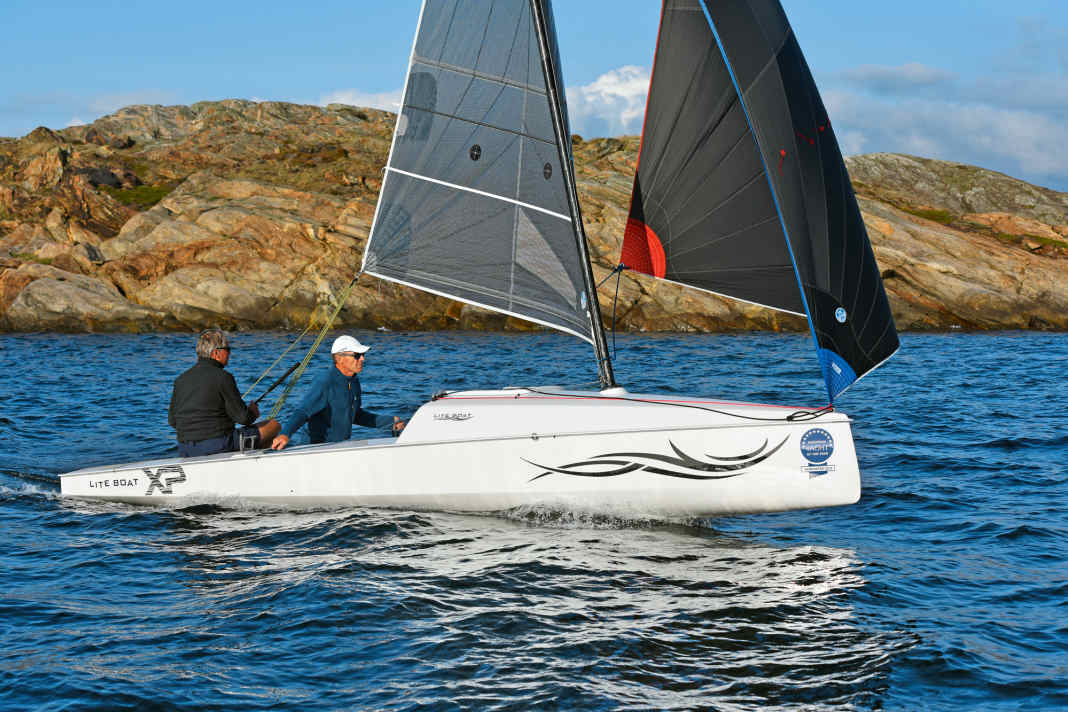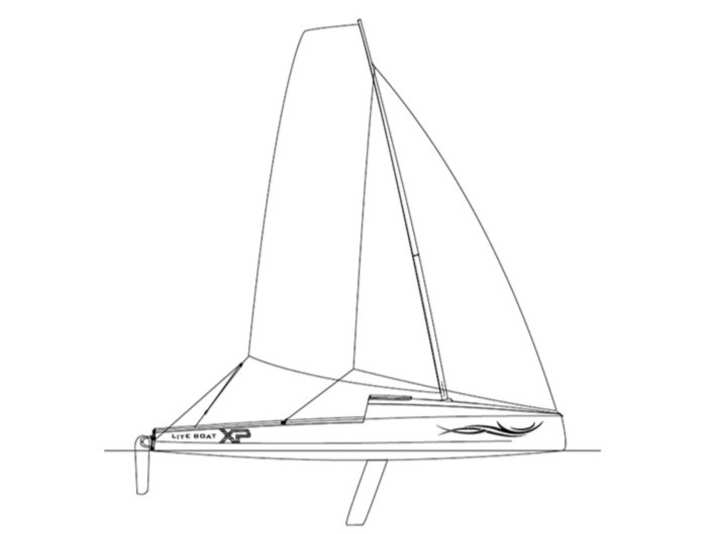





This is the story of a rather unusual boat. And perhaps a preliminary remark, a kind of safety note, would therefore be appropriate. So please bear with us for the following paragraph, especially as an introduction. You will realise later on that we mean well.
So, to be on the safe side, here is the safety warning: "WARNING! The vehicle described below is suitable for exerting a life-changing influence! In particular, it may lead to adventurous excursions far from civilisation."
Other special boats:
The sheer impossibility of categorising this Wolpertinger-like vehicle shows that it can have a standard-breaking effect. The thing doesn't fit into any niche of the usual boat market. It cannot even be clearly categorised linguistically, which underlines its hermaphroditic nature. Should we say "the Liteboat" - as in "the special boat"? Or is it better to say "the XP" - as in "the dinghy", "the yacht"? You almost want to call your former German teacher in this dilemma of determinants. But he could be of little help when it comes to the question of what exactly is floating in the water: Rowing boat? Travelling dinghy? Small cruiser? We're going to make a commitment at this point, at least in relation to the article, because playing around is rarely a solution. Otherwise, explicitly not. Because the Liteboat XP really is many things at the same time.
Innovation on the water
Normally, such experiments go half wrong at best. We remember the now almost extinct genre of motorised gliders, which had already passed its zenith in the late eighties and early nineties. Former bestsellers such as the MacGregor 26, which now only leads a shadowy existence as a licence replica, or recent attempts such as the Nuva MS6, which was converted into a pure motorboat after two lean years and only became a sales success as such.
Seen against this backdrop, the development from Grenoble, which is not exactly known for its nautical heritage or even its proximity to the water, must seem like one big gamble. Or, to put it another way, the idea of a complete madman. And that happens to be a pretty good description.
The madman's name is Matthieu Bonnier, and he came up with the XP out of his enthusiasm for - let's say: very selective - outdoor and endurance sports. The man is a fitness phenomenon, a recreational athlete consisting solely of muscle fibres and tendons: rower, cyclist, mountain and cross-country skier. With the strength of his arms and two oars, he has already crossed the Atlantic and conquered the Northwest Passage. He has competed in the legendary Iditarod sled dog race in Alaska, from Anchorage to the former gold mining settlement of Nome on the Bering Sea.
Strictly speaking, Bonnier is not a sailor - too tranquil, too unstrenuous. But there was this regatta in the north-west of the USA, which leads from Port Townsend in Washington State to Ketchikan in Alaska, past Vancouver Island, Moresby and Graham Island, 750 miles along deserted, sometimes completely undeveloped coasts, inhabited by grizzlies, at times impassable due to extreme tides.
Liteboat XP stands for Adventure
Bonnier had already taken part in this "Race2Alaska" (see YACHT 17/15) in 2016, back then with a heavily modified rowing boat that was transformed into a tri with auxiliary sails using two floats and a small cat rig. However, his big boat proved to be too small on the long journey north, so he spent a lot of time rowing while travelling solo. And thinking.
Because at some point, even he, the marathon man, got fed up. In his head, he was already thinking about a new, even better vehicle - preferably for two people. "After all, adventures are best when you can share them," the Frenchman realised. As soon as he got home, he got to work. This is how the Liteboat XP, an acronym for "Expedition", was born. Perhaps you can now guess why we have prefaced this text with a warning.
Matthieu Bonnier is a boatbuilding expert, albeit a latecomer and career changer. He originally studied veterinary medicine, worked as a vet with his own practice, then founded a chain of pet food shops that was so successful that the German company Fressnapf got involved. After a transitional phase, Bonnier cashed out and went rowing - across the Atlantic.
Looking back, he describes the passage as "one of the worst experiences" of his life as an athlete. But it gave him a new business idea: from then on, he wanted to build rowing boats. Not just any boats, but particularly light ones with a lot of stability thanks to wide hulls that would quickly become fun even for the less experienced.
Liteboat XP with dual use
He found a congenial designer in Sam Manuard, who had already made a name for himself with Minis, Class 40s and Seascapes. And then, in 2012, things took off with Liteboat, a shipyard that now produces 280 units per year, has high double-digit growth rates - and has also included sailing models in its programme since 2018.
Of course, the boss did not miss the opportunity to put his sailboat through its paces - at the Race2Alaska. Which was promptly successful and earned him the special prize for the best-placed small boat, along with the realisation that his XP really can take a beating.
From every angle, it is an unconventional creation. The superstructure curves convexly over the foredeck like a 505, the hull-deck connection is made via a wide, slightly protruding flange. Hard chines outline the flanks almost up to the bow, whose stem is slightly negative. The cockpit takes up more than half the length of the hull - a flat hull in which hardly anything resembles a rowing boat. This is because the furling seat and footrests disappear below deck when sailing. Only the oars lashed to the sides of the cockpit reveal the dual purpose of the boat.
Expedition dinghy is unsinkable
The construction of the Liteboat XP is extremely high quality. The hull and deck are made of foam sandwich. The glass fibre and carbon fibre mats as well as the core material including frames and stringers are impregnated with resin in a single operation using a vacuum process. This ensures a light and strong bond. Only a few shipyards work this way nowadays.
The carbon fibre mast, which is unstayed in a holder in the foredeck, is lined with waterproof foam. Together with the fully retractable ballast centreboard, this prevents capsizing. The XP remains stable on its side even when one person is on board, which is why it fulfils CE category C - meaning it can withstand up to 6 Beaufort winds and two-metre-high waves. It is also unsinkable thanks to its permanently laminated buoyancy bodies. These are all features that come as no surprise given its purpose for long-distance regattas in the wilds of Alaska.
We were able to sail the expedition dinghy as part of the tests for the European Yacht of the Year award, where it is nominated in the same category as this category: special boats. Matthieu Bonnier took the opportunity to show off his creation in the western Swedish archipelago around the boat-builder's island of Orust - an area that is not exactly known as lovely when the Skagerrak is blowing.
For two days, the XP had to prove herself in a wide wind window: from 8 to 12 knots to over 20 knots. She managed this excellently, almost frighteningly well. With a crew of two, her upwind potential in light winds occasionally left something to be desired: at 2 to 3 Beaufort, she couldn't do more than 4.5 knots at crosswind. She clearly lacks sail area and a jib.
But in fresher conditions, she logged up to 6 knots at tacking angles of around 90 degrees, which is very respectable. What was even more astonishing was how dry she sailed. Thanks to her low displacement, she always floats on top like a cork and hardly takes on any water.
Switch from sailing to rowing
The Frenchwoman with the rather small gennaker starts planing early on: 10 to 12 knots of wind are enough for her to outrun her stern wave. This is already the case at a speed of 6.5 to 7 knots, a moment when it becomes very quiet on the XP. However, even at much higher speeds, she remains calm. In the test, it reached up to 12.5 knots through the water without any nervousness - and outperformed much sportier and larger boats in the process.
The rudder pressure always remains low and operation is child's play. Otherwise you only have to operate the mainsheet downwind. But even under gennaker, the cockpit layout is quite suitable for single-handed sailing. There is no need for a main boom - it would only get in the way when rowing anyway.
Speaking of rowing: Switching from sail mode to auxiliary drive is quick and easy. In case of doubt, you can even leave the main on its side and simply secure the carbon straps in the cleats on the side decks, place the furling seat in the laminated recesses and lock the footrests in a recess in the cockpit tub. This takes less than a minute - and you're ready to go, even in calm conditions.
Camping on the Liteboat XP
A reasonably experienced rower with a normal level of fitness can propel the Liteboat XP up to 4.5 knots for short periods; over longer distances, a speed of 3 knots is realistic. That's not a lot, but it's sufficient in view of the good sailing characteristics - often you don't even have to put your hands on it.
Is it even possible to live on the Wolpertinger (or Blutschink, Dilldapp, Elwetritsch, Hanghuhn or Rasselbock) in the end? Well, yes and no. Living, that term would be going a bit too far. Better to say: camping. Because Sam Manuard's design doesn't offer much more than storage space for luggage (not so little) and a double berth (2.10 metres long, 1.45 metres wide, after all!). For a travelling dinghy, however, this is very impressive, especially as the living space can be significantly increased with a suitable dome tent.
Matthieu Bonnier, the madman, has created a rather ingenious little boat out of a quirk. Rowing it is healthy and environmentally friendly. Under sail, it is ideal for inland waterways or sheltered stretches of coastline. Adventurous types can also do much more with it, for example in Alaska. But don't say afterwards that we didn't warn you!
Technical data of the Liteboat XP

- Design engineer: Sam Manuard
- CE category: C
- Lüa (torso length): 5,99 m
- Width: 1,78 m
- Depth: 0,14/1,08 m
- Weight: 165 kg
- Sail area main/gennaker: 9,8/11,0 m²
- Sail carrying capacity: 5,8
- Dealer Germany: www.liteboat.com/de/
The article was first published in 2018 and has been revised for this online version.

